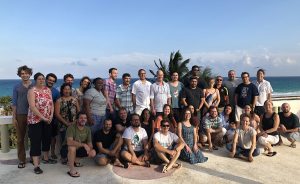April 2-5, 2019
Playa del Secreto
Puerto Morelos, Quintana Roo, Mexico
Info: https://marinebon.github.io/p2p/index.html
This workshop gathered 35 experts in marine ecology, satellite remote sensing and data science from 12 countries to move forward the construction of the Marine Biodiversity Observation Network Pole to Pole of the Americas (MBON Pole to Pole). In Mexico we advanced goals and skills developed during our first meeting in São Sebastião, Brazil (August 6-10, 2018) to continue the establishment of a community of practice dedicated to detecting change in marine biodiversity, understanding why such changes happen, and generating knowledge, data synthesis products and applications that inform conservation and management strategies of marine living resources. The MBON Pole to Pole is a multi-disciplinary, international effort engaging researchers, managers and policy-makers with interest in biodiversity monitoring and science.

During this workshop MBON Pole to Pole members improved agreed field sampling protocols for rocky shores and sandy beaches to ensure that they take into account the highly variable characteristics of these habitats across the continent. Participants worked on data sets collected at their study sites after the workshop in Brazil using standard workflows for data sharing, analysis and visualization relying on Darwin Core vocabularies and taxonomic quality control tools provided by the World Register of Marine Species (WoRMS). A central goal of the workshop was to build capacity in the use of satellite remote sensing information and its integration with in situ biodiversity inventory observations. Other activities included developing metadata terminologies for flora and fauna of rocky shore and sandy beaches measured during field surveys following Ecological Metadata Language (EML) standards. Also, data collected during biodiversity surveys across 14 sites in the Americas from August 2018 and March 2019 was uploaded to the MBON Pole to Pole Integrated Publishing Toolkit of the Global Biodiversity Information Facility, and thus is ready for sharing via OBIS to become discoverable and publicly available.
